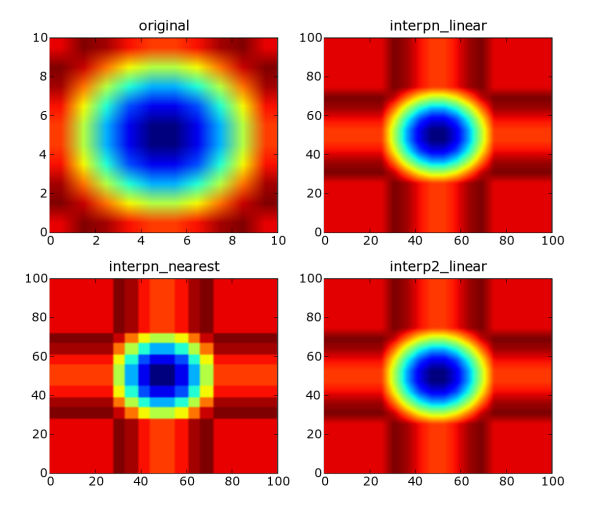
Look at Cookbook/Interpolation before reading this. SciPy probably has the interpolation functions you need.
Here are some homemade interpolating functions I use that may be usefull to others. They may still contain a lot of bugs, but...
1 from numpy import *
2
3
4 def interpn_nearest( z, targetcoords, bincoords=None ):
5 '''Interpolate some data, z, located at bincoords in the target locations targetcoords
6 using nearest neighbor interpolation.
7 z - is the data array
8 targetcoords - are the coordinates where we want to evaluate the data.
9 It must have a format so that z[targetcoords] would make sense
10 if targetcoords where integers.
11 mgrid and ogrid can be used to get such a format.
12 bincoords - is a list of arrays. Each array should containt.
13 '''
14 coords = interpn_check_data(z,targetcoords,bincoords)
15 indices = [ c.round().astype('i') for c in coords ]
16 return z[indices]
17
18
19 def interpn_linear( z, targetcoords, bincoords=None ):
20 '''Interpolate some data, z, located at bincoords in the target locations targetcoords
21 using linear interpolation.
22 z - is the data array
23 targetcoords - are the coordinates where we want to evaluate the data.
24 It must have a format so that z[targetcoords] would make sense
25 if targetcoords where integers.
26 mgrid and ogrid can be used to get such a format.
27 bincoords - is a list of arrays. Each array should containt.
28 '''
29 coords = interpn_check_data(z,targetcoords,bincoords)
30
31 indices = [ x.astype('i') for x in coords ]
32 weights = [ x-i for x,i in zip(coords,indices) ]
33
34 res = z[indices]*0
35
36 for selector in ndindex( *z.ndim*(2,) ):
37 weight = 1
38 for w,s in zip(weights,selector):
39 if s: weight = weight*w
40 else: weight = weight*(1-w)
41 value = z[ [ i+s for i,s in zip(indices,selector) ] ]
42 res += weight*value
43
44 return res
45
46
47
48 def rebin( a, newshape ):
49 '''Rebin an array to a new shape, without interpolation.
50 This can be usefull if the array type is not a vector space.
51 '''
52 assert a.ndim == len(newshape)
53
54 slices = [ slice(0,old, float(old)/new) for old,new in zip(a.shape,newshape) ]
55 coordinates = ogrid[slices]
56 indices = [ c.astype('i') for c in coordinates ]
57 return a[indices]
58
59
60
61 #################################
62 ## more internal functions
63
64 def array_coordinates( targetx, binx ):
65 '''Computes the coordinates in an array reference.
66 targetx are the coordinates of the points that we want to get in the array reference.
67 binx are the coordinates of the array bins
68 Example:
69 >>> array_coordinates( [2, 10], [1, 3, 13] )
70 [0.5, 1.7]
71 '''
72 tol = 1e-12
73 binx = asarray(binx)
74 nx = clip( targetx, binx.min()*(1+tol), binx.max()*(1-tol) )
75
76 i = searchsorted( binx, nx ) # index of the biggest smaller bin
77
78 bx = empty((len(binx)+2,), 'd') # avoid probles at the border
79 bx[0] = binx[0] - 1
80 bx[1:-1] = binx
81 bx[-1] = binx[-1] + 1
82
83 return i-1 + ( nx - bx[i] )/( bx[i+1] - bx[i] )
84
85
86 def interpn_check_data( z, targetcoords, bincoords ):
87 '''Check the validity of the input data for intepn_x functions
88 and returns the target coordinates in the array reference
89 '''
90 dim = z.ndim
91 if bincoords:
92 if len(bincoords) != dim:
93 raise ValueError, 'bincoords shape mismatch.'
94 for i in range(dim):
95 if prod(bincoords[i].shape) != z.shape[i]:
96 raise ValueError, 'bincoords shape mismatch.'
97
98 coords = [ array_coordinates(targetcoords[i],bincoords[i].ravel()) for i in range(dim) ]
99 else:
100 coords = targetcoords
101 return coords
102
103
104 def interp2_linear( z, tx, ty, binx=None, biny=None ):
105 '''Toy function just like interpn_linear in 2 dimensions.
106 This function exists just to help the understanding and mantaining of interpn_linear.
107 '''
108 if not binx is None: tx = array_coordinates( tx,binx )
109 if not biny is None: ty = array_coordinates( ty,biny )
110
111 ix = tx.astype('i')
112 iy = ty.astype('i')
113 wx = tx-ix
114 wy = ty-iy
115
116 return (1-wy)*(1-wx) * z[iy ,ix ] \
117 + (1-wy)* wx * z[iy ,ix+1] \
118 + wy *(1-wx) * z[iy+1,ix ] \
119 + wy * wx * z[iy+1,ix+1]
120
121
122
123
124
125
126 ###########################################
127 ## some visual testing
128 ##
129 import pylab
130
131 def test():
132 x,y = ogrid[ -1:1:10j, -1:1:10j ]
133 z = sin( x**2 + y**2 )
134
135 binx = (x,y)
136 tx = ogrid[ -2:2:100j, -2:2:100j ]
137
138 pylab.subplot(221)
139 pylab.title('original')
140 pylab.imshow(z)
141 pylab.subplot(223)
142 pylab.title('interpn_nearest')
143 pylab.imshow( interpn_nearest( z, tx, binx ) )
144 pylab.subplot(222)
145 pylab.title('interpn_linear')
146 pylab.imshow( interpn_linear( z, tx, binx ) )
147 pylab.subplot(224)
148 pylab.title('interp2_linear')
149 pylab.imshow( interp2_linear( z, tx[0],tx[1], x.ravel(),y.ravel() ) )
150 pylab.show()